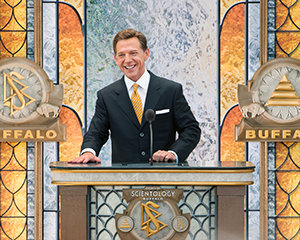Empowering the Mind: Opening the Keys of Scientology
Scientology, a religious system established by L. Ron Hubbard in the 1950s, has actually amassed both intrigue and controversy for many years. With its focus on achieving spiritual enlightenment and enhancing one's psychological wellness, Scientology supplies a distinct point of view on the human mind and heart. Via the application of its core concepts, adherents assert to open covert possibilities and discover a much deeper understanding of themselves and the globe around them. Nevertheless, the keys and practices behind Scientology continue to be shrouded in secret for lots of, leaving an interested gap waiting to be loaded.
The Origins of Scientology
The origins of Scientology can be traced back to the early 1950s when L. Ron Hubbard created the foundational principles of this controversial religious movement. Drawing from his earlier self-help system called Dianetics, Hubbard expanded his concepts to form what would become Scientology. In 1952, he published his influential job, "Dianetics: The Modern Science of Mental Wellness," which prepared for the beliefs and practices that specify Scientology today.
Hubbard's mentors revolved around the principle of the human mind as a database of past injuries, referred to as engrams, which hinder personal development and spiritual development. With a process called bookkeeping, adherents of Scientology aim to clear themselves of these engrams and attain a state of mental clarity and spiritual enlightenment called Clear.
The very early years of Scientology saw rapid development as Hubbard's ideas reverberated with a section of the population looking for alternative methods to self-improvement and spiritual fulfillment. Regardless of running the gauntlet and dispute, Scientology has proceeded to develop and attract fans worldwide, shaping the ideas and lives of its members.
Core Beliefs and Practices
Discovering the basic tenets and rituals of Scientology discloses a complex tapestry of ideas and techniques that lead adherents in their spiritual trip. At the core of Scientology is the belief in the never-ceasing spirit, understood as the thetan, which is seen as real self that goes beyond the real world (Scientology). Scientologists look for to shed adverse past experiences via a process called auditing, where a therapist helps individuals resolve trauma and unfavorable feelings to reach a state of spiritual health
Central to Scientology is the method of Dianetics, a collection of techniques and ideas created by L. Ron Hubbard that aims to enhance mental health and wellness and self-awareness. Via Dianetics, followers strive to achieve a state of "clear," where they are without the adverse results of past injuries and can totally realize their spiritual capacity.
In addition, Scientology stresses personal development and self-improvement with courses and therapy sessions aimed at enhancing interaction abilities, partnerships, and general well-being. These practices form the structure of Scientology's strategy to spiritual knowledge and empowerment.
Dianetics: The Scientific Research of the Mind
Diving into the depths of Scientology discloses Dianetics as the fundamental science directing followers on a journey of psychological health and wellness and self-awareness. Established by L. Ron Hubbard, Dianetics focuses on the mind's reactive mind, which shops unpleasant experiences, causing negative behaviors and feelings. The core facility of Dianetics is that these negative experiences can be attended to with a process called bookkeeping, where people recall and confront previous traumas to attain a state called Clear.
Investigating in Dianetics entails using an E-meter, a device that gauges the modifications in electrical resistance of the skin, thought to mirror psychological actions. By identifying and addressing these past distressing experiences, individuals intend to accomplish a state of psychological clearness and emotional well-being. With this process, followers strive to reach their complete capacity and improve their general quality of life by releasing themselves from the burdens of previous negative experiences. Dianetics functions as a device for individuals to recognize the workings of their own minds and overcome restrictions that hinder personal development and happiness.

Achieving Spiritual Enlightenment
Structure upon the foundation of Dianetics, the pursuit of spiritual knowledge within Scientology encompasses a profound trip towards internal peace and transcendence. Attaining spiritual enlightenment in Scientology includes a series of trainings and practices made to aid individuals get to a state of higher recognition and understanding of themselves and the world around them.

Scientologists believe that by increasing their understanding of the thetan and attaining a state of spiritual clarity, they can attain a greater level of consciousness and recognition (Scientology). This i loved this increased recognition is thought to cause a sense of internal peace, consistency, and connection to deep space
Using Scientology Principles
Applying the fundamental concepts of Scientology in daily life basics calls for a deep understanding of its trainings and a commitment to personal development and development. One key element of applying Scientology concepts is the method of improving communication abilities.
Another vital element of applying Scientology concepts is the principle of ethics and integrity. Scientologists are motivated to live morally and honestly, taking duty for their actions and choices. Scientology. By straightening their behavior with their concepts and worths, individuals can cultivate a feeling of honesty and self-worth
Furthermore, applying Scientology concepts involves the pursuit of understanding and self-improvement. Scientologists worth continual understanding and individual development, aiming to increase their understanding of themselves and the globe around them. Via study and reflection, individuals can grow their expertise of Scientology teachings and integrate them into their every day lives, fostering personal growth and empowerment.
Conclusion
In conclusion, Scientology, founded by L. Ron Hubbard, is a religious beliefs that focuses on accomplishing spiritual enlightenment through the practice of Dianetics and adherence to its core ideas. By using Scientology concepts, fans look for to enhance their psychological wellness and accomplish a higher state of consciousness. With the research and application of its trainings, people aim to unlock the secrets of the mind and reach a higher understanding of themselves and the globe around them.

Comments on “Famous Followers of Scientology: Stars and Their Faith Journey”